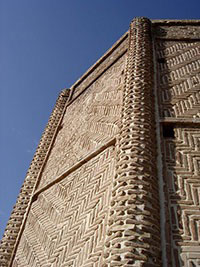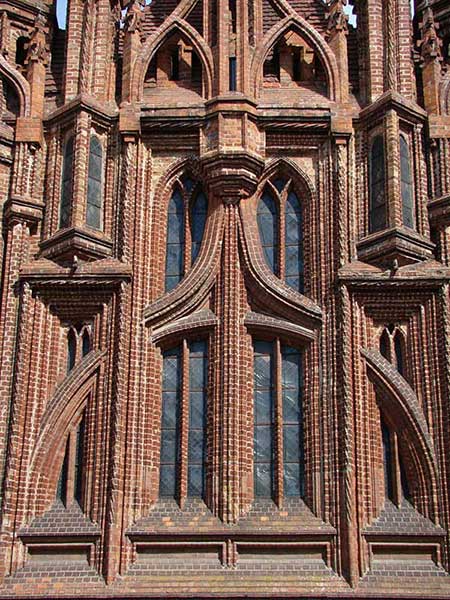Red Bricks
Using Red Bricks in building construction
Red bricks are widely used for building construction.
Here we talk about history, how clay bricks are made and fired, differences in quality and strength, how to select a good brick and how they should be used.
What is brick?
A brick is a small rectangular block of fired or sun dried clay. It is a beautiful building material with warm colours, a natural appearance and, once built, it needs no ongoing maintenance. The use of bricks goes back thousands of years.

Some say that it was the arabs that invented bricks. Certainly the middle east has a long history of using bricks as can be seen in the 12th century Iranian Shibeli Tower.
The Ancient Greeks used bricks and the Romans built brick buildings wherever they went.
The Strength of Bricks
In Britain brick buildings are strong.
The bricks tend to be very hard and dense and have been used for centuries as structural bricks ie bricks that provide the structural strength of buildings, they support roofs and floors and are used without any reinforcement. They were used to build large buildings, churches, factories and even tall factory chimneys. The victorian sewerage systems in major towns and cities were built from brick and still survive today. Of course all this is possible because the ground is very stabple, the earth doesn't move much for the people of Britain.
Accrington, a small town in Lancashire, is known for making the hardest, densest bricks in the world. Accrington brick was shipped to America and used to build the foundations of the Empire State building.
In Britain bricks are widely used for house building. Walls are usually built as double skin "cavity" walls (effectively two single thickness brick walls with a gap between them) . The cavity provides both thermal and sound insulation.
In Australia bricks are mostly used for aesthetic rather than insulation purposes.
While some engineering brick is used for apartment blocks, industrial buildings and the like these tend to be used for cladding. The majority of bricks are used for housing and "brick veneer" is a standard house building method. Houses have lightweight wooden wall frames which are lined on the inside with plasterboard (gyprock) and covered on the outside by a veneer wall of brick. For this purpose bricks don't have to be very strong.

The Manufacture of Bricks
Three things determine the strength of the brick itself. The clay mixture, the compaction and the firing.
Manufactured bricks contain 50% to 60% silica (sand), 20% to 30% alumina (clay), 2% to 5% lime, up to 7% iron oxide and a little magnesia. In many places the local people simply use whatever is available to them. The resulting mixture has water added to make a soft mud which is formed into rectangular blocks and either left in the sun to dry or are fired in a kiln.
Fine grained clays tend to be denser, it fires better and produces stronger bricks. To increase their hardness bricks may be formed in a press to increase the density and remove any small pockets of air from the clay before firing.
When firing the clay needs to reach 900°C to 1,000°C so the silica will fuse together to give the brick strength.
The colour of bricks depends on the chemical and mineral content of the clay and the temperature it is fired at. Iron gives bricks their red colour while yellow bricks have a lot of lime in them. Cooler temperatures produce red bricks, hotter temperatures progress through browns to greys.
When built into a wall the wall strength is further determined by the shape of the brick (does it have a frog in it - a frog is an indent in the surface to help them "key" together) the strength of the mortar (how much cement is used - it needs to be 4 parts sand to 1 of cement) and the way the bricks are placed in relation to each other.
Average brick sizes
The size of bricks is important. Bricks must be large enough to minimise the amount of work needed to build with them but light enough for a bricklayer to easily handle them.
Over the centuries an optimal size of brick has developed which doesn't vary much from country to country. A standard brick (when the thickness of mortar is included) is around 9" long, 4½" wide and 3" thick (note we are talking in inches). Earlier bricks and traditional Balinese bricks tend to be thinner - about 2" thick
The dimensions, ie.ratio 6 : 3 : 2, is important. It gives numerous possible combinations of brick placements in relation to each other permitting considerable creativity in the shape and form of brick structures.
In Indonesia bricks have been used for centuries. Here the strength of bricks varies considerably but, due to the risk of earthquakes, they MUST be used in combination with concrete columns and beams to provide structural strength. Around half a million houses collapsed in the 2006 Yogya earthquake. The cause - single skin brick walls built from weak brick with no reinforced concrete columns or beams. They were not strong enough to support the weight of the roofs - a bit of a wobble and down they came.
Finding Good Quality Bricks
If you are doing any building work it is a good idea to check the quality of the bricks before they are used, by the time they are hidden in a wall under layers of cement you have no way of telling how strong the wall is.
It is important to find a source that supplies strong bricks with a consistent quality. Here in Bali bricks are produced in various parts of the island and vary considerably according to the quality of the clay used and the skill of the people making them. Unfortunately there are a few people around who like to save a bit of money by adding "fillers" (rice chaff, dog poo, etc.).
The clay must be fine grained and have the right combination of clay and sand, they should be dense with no air gaps and finally they must be fired at sufficient temperature to fuse the silica. You can find nice rustic looking bricks but be careful, they will not be as strong as pressed bricks.
In small local operations bricks are stacked in wood fired kilns with airways through the stack to allow hot air to pass through. After firing the bricks are sorted according to hardness as they are removed from the kiln. Those at the bottom will have reached a higher temperature and will be harder, those in the middle are general purpose bricks while those at the top will be softer and are often used for traditional building.
In Bali you will see bricks used in some very interesting ways. Traditional Balinese building techniques use red bricks that are soft so they can be rubbed together (gossok) to get a very close fit. These are then cemented together using a thin cement and water paste making the joints between the bricks almost invisible. Using soft bricks also allows them to be carved easily.
The best Balinese bricks I have come across are from Tabanan and from Tulikup (South East of Gianyar). In Tulikup you will find dozens of small family operated kilns. The earth in that area is particularly good for brick making but beware, like all handmade products the quality of the bricks varies according to the skills of the people making them.
Testing bricks
So how do you know how strong a brick is? The simplest test is to bang them lightly together - if they are properly fired they will give a ringing sound, if not sufficiently fired they will sound more like a dull thud.
You can try dropping them - a hard brick will be brittle and break cleanly. Look at the inside of the break and try pulling pieces out of it. If it is not fired properly you may find it will crumble and fall apart in your hands.
I use a concrete hardness test hammer - not designed for the job but still very effective.
Finally remember that understanding about bricks may save your life. If you want to avoid waking up in the night in fear of an earthquake make sure that your house has a bit of reinforced concrete to hold it.
Phil Wilson
Copyright © Phil Wilson September 2015
This article, or any part of it, cannot be copied or reproduced without permission from the copyright owner.
